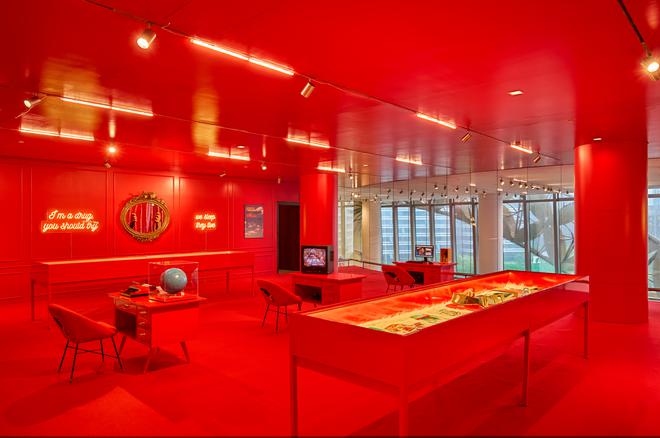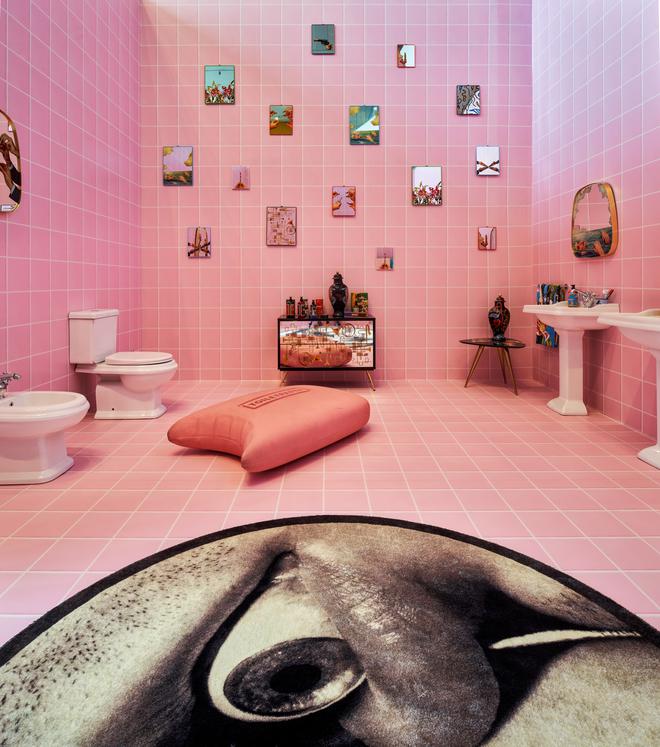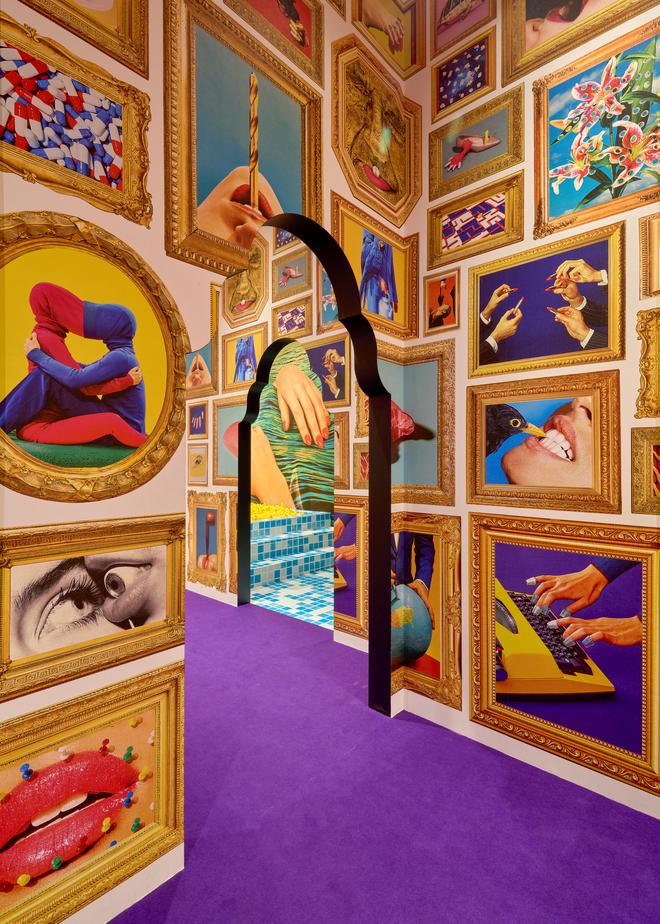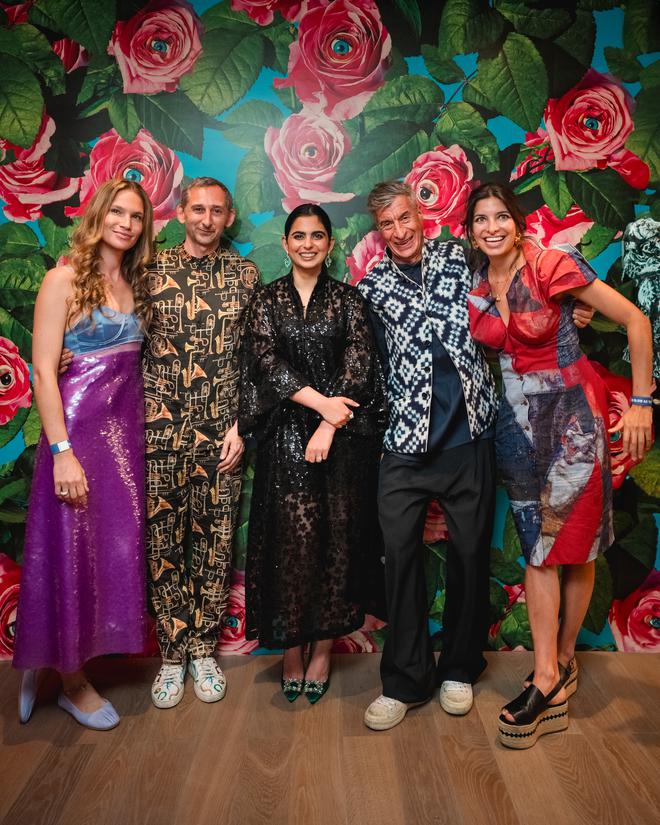The fourth floor of the Art House at the Nita Mukesh Ambani Cultural Centre is currently a red room. Not a torture chamber, not quite a villain’s lair, but a more Lynchian vision of an HQ or “control room” of Toiletpaper, this is the final chapter in the sprawling exhibit Run As Slow As You Can.
On either end of the control room are vitrines exhibiting the photography-only magazine’s long history in media. On the walls hang pithy quotes as neon signs such as “Tell the truth and run” and “I’m a drug you should try”. In the centre of the room are two officious-looking red tables and chairs. On the first sits an old TV, on which plays a video of a man quietly working in an artist’s studio. On the other is a DELL desktop and on its screen is a rooster’s head floating in outer space. “The Oracle” will answer any question you type into a floating text box, even to something as rhetorical as: “What will the world be like in 3023?” Pat comes the reply: “Like a surrealist dreamscape painted with shades of unknown.”

Run As Slow As You Can is Toiletpaper’s largest show since they debuted in 2010. Curated by Mafalda Millies and Roya Sachs, this is a wholesome tribute to the absurd, irreverent, playful universe that the world-famous Italian artist Maurizio Cattelan and renowned Italian fashion and design photographer Pierpaolo Ferrari have built over the last decade.
Of cardboard, paint and mirrors
The show is divided into four chapters, beginning with ‘Take a Left, Right?’, a maze of sorts where your path is lined with blown-up imagery from Toiletpaper’s archives. Heavily mascaraed eyes, breakfast food nailed down to tables, cat heads for burger patties — as you puzzle your way out, you take the hint. This explosion of desire, irony and gluttony is not quite what the glossies advertised.

Ascending the stairwell covered in spaghetti wallpaper, you come upon the second gallery: ‘Is There A Room In The Sky?’ With mirrors on two ends, and every other surface painted a sky blue with white clouds, the air here is more rarefied. Large cut-outs of Toiletpaper images hang suspended from the ceiling: a globe with USA painted golden; a group of hands offering lipstick. It’s as if you’re in the window seat of an aeroplane flying through a funhouse.

For an experience built out of cardboard, paint and mirrors, these two chapters are immersive. “The word ‘immersive’ has become somewhat taboo in the art world today,” says Millies. “Art has become more commercial and accessible in many ways, and immersive art has in some ways helped do this, albeit the often misuse of the word.”
Destined for Instagram glory
All sense of reality continues to evaporate in Chapter 3: ‘A House Is a Building That People Live In’. Opposite the Taj Mahal plastered on one tall wall, stands a spaghetti covered Fiat, and next to it an arched doorway to a luxurious home stands open. Giant roses bloom and trumpets and trombones boom on the walls. An old Philips RL 191 radio plays an old Kishore Kumar song.

But, to your shock and delight, there is a body under the carpet in the living room. The pool is full of plastic bananas. The fridge opens on to a grave with the epitaph “The End”. And there is no roof — which makes the control room above, with its large windows, a voyeur’s cove.

Thrilling, accessible, hyper-saturated and bursting with sly references that nudge and wink at you, Run As Slow As You Can is the sort of experiential art event that is destined for Instagram glory. But it is also much more than that. To produce a show of this scale from their offices in Europe was a huge challenge, says Elizabeth Edelman, executive producer of TRIADIC, the global creative house and cultural engine that’s put together the show.
They were also keen to highlight Indian workmanship and artisanry, and to bring to life the vision of Toiletpaper, which is “inspired by surrealism, Dadaism, and investigating our hyper consumption of imagery”. Like pop artists of his generation and those before him, consumption and consumerism has been of special interest to Cattelan.

Provocative visual storytelling
Before Toiletpaper magazine came into being in 2010, he had built himself a global reputation in the 1970s. His work blended the pop ethos of Andy Warhol with the modalities of Andy Kaufman or the court jester. On one occasion, Cattelan duct-taped an art dealer to the wall of his gallery.
Soon, he announced his retirement from the arts. Toiletpaper was born out of a collaboration between Cattelan and Ferrari in 2009. Back then, Cattelan described the magazine as “the representation of the digestive process following an overdose of images”. He tells the Magazine now, “If the digestion is still on, then that was quite a feast of images!” Ferrari adds, “Perhaps we could exchange ‘overdose’ with ‘binge watching’, just because after all this time there is plenty to look at and even more to come. Besides, thresholds to addictive visual consumption are overrated.”

Between then and now, aside from releasing issues of the magazine periodically — which quickly become collector’s items — the pair have worked with high fashion brands such as Kenzo. Toiletpaper also expanded their vision to design, home appliances, exhibitions, and beauty products — some of which are part of Run As Slow As You Can.
“Toiletpaper has remained hopelessly devoted to itself,” says Ferrari. “We still print our magazine. But other than that? It still remains just a twisted, frisky, provocative visual storytelling.”
The writer is an independent journalist based in Mumbai, writing on culture, lifestyle and technology.







